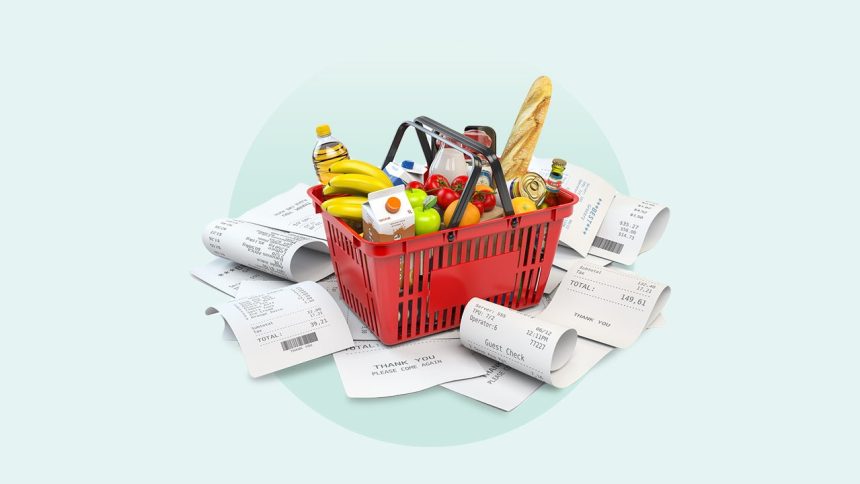Many Americans spend a sizable amount of their income to keep a roof over their heads, food on the table and a means of transportation. Other items commonly found in household budgets include education, child care, health care, retirement savings and entertainment.
Inflation has cooled significantly from its 40-year-high in 2022, yet prices remain elevated on various goods and services, leaving consumers with less money in their budgets for such financial matters as savings and debt repayment.
During this era of persistent inflation, more Americans associate financial success with living comfortably than with being a millionaire or having a high-paying job. More than half (56 percent) say that to be financially successful, one needs to live comfortably — defined as being able to afford day-to-day expenses and still having enough money left over to put into savings — Bankrate’s Financial Success Survey found.
You can take stock of how your own budget compares by looking at the average American household budget.
Key household budget statistics
The average household earned $101,805 in 2023 before taxes and spent $77,280, according to a survey by the most recent Consumer Expenditure Survey. The report, published by the U.S. Bureau of Labor Statistics (BLS), lists the average amount spent in various categories. Significant expenditures were housing, transportation and food.
| Average 2022 household earning and expenditure statistics | |
|---|---|
| Household earnings | $101,805 |
| Total household expenditures | $77,280 |
| Housing expenditures | $25,436 |
| Transportation expenditures | $13,174 |
| Food expenditures | $9,985 |
| Increase in household expenditures from 2022 | 5.9% |
| Percent of expenditures that goes toward housing | 32.9% |
Impact of inflation on expenses
In the aftermath of the COVID-19 pandemic, inflation reached 40-year highs as demand increased thanks to stimulus checks, low interest rates and government spending, while the economy slowed due to shutdowns. Labor costs increased due to a shortage of workers, and consumer demand was high, causing businesses to increase prices.
Although inflation has cooled significantly, prices remain high on many items, which impacts people’s ability to save. Only 16 percent of U.S. adults say they have enough emergency savings to cover between three and five months’ worth of living expenses, while 27 percent report having no emergency savings at all, Bankrate’s 2024 Emergency Savings Report found.
What’s more, the same survey found nearly two-thirds of Americans (63 percent) said that inflation is causing them to save less for unexpected expenses.
Average American household expenses
According to the BLS survey, the largest expenditures were housing and transportation, which comprised 32.9 percent and 17 percent of total expenditures, respectively. Another big spending category was food, to which 12.9 percent was devoted.
Roughly 90% of Americans surveyed by Debt.com in 2024 reported they budgeted their money, a number that’s been trending upward since 2018. The vast majority of budgeters in the survey said the practice got them out of debt or kept them from going into debt.
One way some people afford living expenses without going into debt can be having a side hustle. In fact, 36 percent of Americans who have a side hustle to earn extra money use that income to pay for regular living expenses, according to Bankrate’s 2024 Side Hustle Survey.
Cost of living expenses
Income taxes
The average pre-tax income per household in 2022 was $94,003, according to the most recent BLS survey data. Every year since 2018 — with the exception of 2023 — married households filing jointly with that income have been in a lower tax bracket than single filers, head-of-household filers and married couples filing separately with that income.
Retirement contributions
The average amount people had saved for retirement in 2024 is $88,400, which is down from $89,300 the previous year, according to Northwestern Mutual’s Planning & Progress Study.
Data from the same study breaks down average retirement savings by generation in 2024:
| Generation | Average amount saved for retirement |
| Generation Z (ages 18-26) | $22,800 |
| Millennials (ages 27-42) | $62,600 |
| Generation X (ages 43-58) | $108,600 |
| Baby boomers (ages 59-77) | $120,300 |
Roughly one in five Americans (22 percent) regret not saving for retirement early enough, Bankrate’s 2024 Financial Regrets Survey found. In fact, less than half of Americans (46 percent) have stock investments in a retirement account or other investment account such a mutual fund, brokerage account or health savings plan (HSA), Bankrate’s 2023 Investing Survey found.
Bankrate’s take
48% of Americans believe it’s not likely they’ll be able to save enough money to comfortably retire, Bankrate’s 2024 Retirement Savings Survey found.
Household expenditures
Average cost of utilities
On average, people spend around $380 a month on electricity, natural gas, water, trash and sewer services, according to Move.org. This comes out to $4,560 in a year.
- Electricity: $136.84
- Natural gas: $69.38
- Water: $47
- Sewer: $65
- Trash: $62.50
The cost for some utilities can fluctuate depending on the season. For instance, people’s natural gas costs are often higher during the months they turn on the heat, whereas their electricity bill is higher when they use the air conditioner. Utility bills often vary by state and by climate.
Ways to save on utility bills include fixing leaky faucets and making sure unused lights are turned off. During the colder months, you can save by turning the heat down when no one is home or by lowering the heat a couple of degrees and wearing extra layers.
Average cost of food
A significant portion of most household budgets is devoted to food. Food was the third largest spending category for Americans in 2023, according to the BLS survey — and it’s been getting more expensive due to inflation. Over the past year, the price of food eaten at home has risen sharply, by 8.2 percent.
Changes in food prices over a 12-month period ending in October 2024, according to the BLS, are as follows:
| Food | Seasonally adjusted percentage change ending in October 2024 |
| Meats, poultry, fish, and eggs | +1.9% |
| Cereals and bakery products | +0.9% |
| Dairy and related products | +1.3% |
| Fruits and vegetables | +0.9% |
| Nonalcoholic beverages and beverage materials | +1.7% |
Nearly half (47 percent) of Americans say money has a negative impact on their mental health, at least occasionally, causing anxiety, stress, worrisome thoughts, loss of sleep, depression or other effects, Bankrate’s 2024 Money and Mental Health Survey found. More than half (60 percent) whose mental health is affected by money cite paying for everyday expenses, such as groceries and utilities, the survey found.
Ways to combat rising prices and save money on groceries include making a weekly meal plan, swapping expensive cuts of meat for cheaper options, using coupons, buying generic products and sticking to a shopping list.
Average cost of housing
Housing expenses increased 4.7 percent overall in 2023 over the previous year, according to the BLS survey, with the average household spending $25,436 that year on housing. One of the housing costs for homeowners is property taxes.
Total property taxes levied on single-family homes were $363 billion in 2023, which was up from $339.8 billion in 2022, according to real estate data firm ATTOM.
Of Americans who don’t own a home but have a desire to, 78 percent said it’s due to affordability issues, such as insufficient income, home prices being too high and not being able to afford a down payment and closing costs, according to Bankrate’s 2024 Home Affordability Report.
Another housing cost that has been on the rise is rent. The average monthly rent bill rose to $2,009 in October 2024, up from $1,945 one year earlier, according to Zillow’s Observed Rent Index, which lists the following as the most affordable regions to rent:
- Dyersburg, Tennessee
- Rolla, Missouri
- Meadville, Pennsylvania
The data lists the most expensive places to rent as:
- Glenwood Springs, Colorado
- Edwards, Colorado
- Steamboat Springs, Colorado
One way to help brace yourself for possible future rent increases is asking your landlord whether you should expect an increase when your lease is up for renewal. If the answer is yes, knowing this in advance may give you sufficient time to find a new place if you can’t or don’t want to pay the more expensive rent bill.
Additional expenses that affect budgeting
Cost of education
In 2024, families with children in elementary through high school were expected to spend an average of $874 on back-to-school items, according to the National Retail Federation (NRF). It also found that total back-to-school spending was expected to reach $38.8 billion for the school year. Both of these figures reflected record highs since the NRF began collecting back-to-school spending data in 2003.
Cost of college
According to College Board data, the average price of college tuition was as follows for the 2024-25 school year:
- Public, in-state, four-year university: $11,610 (an increase of 2.7 percent over 2023-24)
- Public, out-of-state, four-year university: $30,780 (an increase of 3.2 percent over 2023-24)
- Public, in-district, two-year college: $4,050 (an increase of 2.5 percent over 2023-24)
- Private, four-year, nonprofit university: $43,350, (an increase of 3.9 percent over 2023-24).
In addition to tuition costs, another significant expense for college students is the cost of living. Students living on campus pay an average of $12,302 for room and board at public, four-year institutions, while those living off campus pay an average of $11,983, according to EducationData.org.
The average balance in a 529 college savings account was $27,741 in June 2023, according to the College Savings Plans Network. It also reported there were a total of 16.25 million such accounts with total assets of $450.5 billion.
Transportation costs
Many Americans own a car, and the costs associated with buying and maintaining a vehicle take up a significant chunk of the average household budget. In June 2024, the average price of a new car was $48,401, while the average price of a used car was $25,251, Bankrate reported.
In addition to the significant cost of buying a car, ongoing expenses of owning a vehicle include insurance, maintenance and gasoline. The current national average price for gas is $3.05 a gallon, according to AAA Gas Prices, which lists the highest-ever recorded average price as $5.02 in June 2022.
Around 41.81 percent of vehicles financed in the second quarter of 2024 were new vehicles, Bankrate reported. In the second quarter of 2024, the average monthly payments for new and used vehicle loans were $586 and $734, respectively, according to Experian.
How to budget
Creating a household budget may seem like a daunting task, but it can help alleviate unnecessary costs throughout the year and keep you on track with saving money, whether you want to add to your savings account, lock in a rate with a certificate of deposit (CD) or aim for a higher yield with a money market account. Starting a budget can be as easy as taking some simple steps:
- Determine a budgeting method. There are various budgeting methods, such as the 50/30/20 budgeting rule, which includes separating your income into three portions: needs, wants and savings. A zero-based budget allocates every dollar of your income to categories, including savings.
- Start a worksheet. Whether created on your computer or written on paper, a worksheet is a useful tool for entering line items for money earned and spent.
- Add up your income sources. Your sole source of income may be your regular paycheck, or you might have additional earnings from sources like a side hustle or rental property. Add up all the money you’re bringing in after taxes.
- Track your spending. Create line items for each category of your spending, including housing, utilities, transportation, food, health care, entertainment, other bills, savings and debt repayment. Include fixed expenses that remain the same each month and those that fluctuate.
- Adjust as needed. If your income or needs change, be sure to modify your budget to reflect that. Updating your spreadsheet regularly will help you stay on track and meet your financial goals. Consider setting up reminders on your mobile device to do quarterly reviews of any changes to your income or costs of living.
Frequently Asked Questions
Read the full article here














